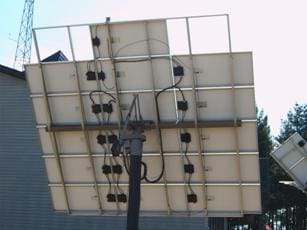Copper conductors are recommended for almost all photovoltaic system
wiring. Copper conductors have lower voltage drops and better resistance
to corrosion than other types of comparably sized conductor materials.
Aluminum or copper-clad aluminum wires can be used in certain
applications, but the use of such cables is not recommended-
particularly in dwellings.
All wire sizes presented in this guide refer to copper conductors. The NEC requires 12 AWG (American Wire Gage) or larger conductors to be used with systems under 50 volts. Article
690 ampacity calculations yielding a smaller conductor size might
override Article 720 considerations, but some inspectors are using the
Article 720 requirement for dc circuits [690.3].
The Code has
little information for conductor sizes smaller than 14 AWG, but Section
690.31(D) provides some guidance. Many listed PV modules are furnished
with attached 14 AWG conductors.
Single-conductor,
Type UF (Underground Feeder—Identified (marked) as Sunlight Resistant),
Type SE (Service Entrance), or Type USE/USE-2 (Underground Service
Entrance) cables are permitted for module interconnect wiring. Type UF
cable must be marked “Sunlight Resistant” when exposed outdoors as it
does not have the inherent sunlight resistance found in SE and USE
conductors [UL Marking Guide for Wire and Cable].
Unfortunately,
single-conductor, stranded, UF sunlight-resistant cable is not readily
available and may have only a 60°C temperature rating. This 60°C rated
insulation is not suitable for long-term exposure to direct sunlight at
temperatures likely to occur near PV modules. Such wire has shown signs
of deterioration after four years of exposure. Temperatures exceeding
60°C normally occur in the vicinity of the modules; therefore,
conductors with 60°C insulation cannot be used.
Stranded wire is
suggested to ease servicing of the modules after installation and for
durability. The widely available Underground Service Entrance Cable
(USE-2) is suggested as the best cable to use for module interconnects.
When manufactured to the UL Standards, it has a 90°C temperature rating
and is sunlight resistant even though not commonly marked as such. The
“-2” marking indicates a wet-rated 90°C insulation, the preferred
rating. Additional markings indicating XLP or XLPE (cross-linked polyethylene) and RHW-2 (90°C insulation when wet) ensure that the highest quality cable is being used [Tables 310.13, 16, and 17].
 |
An
additional marking (not required) of “Sunlight Resistant” indicates
that the cable has passed an extended UV exposure test over that
normally required by USE-2. USE-2 is acceptable to most electrical
inspectors. The RHH and RHW-2 designations frequently found on USE-2
cable allow its use in conduit inside buildings. USE or USE-2 cables,
without the other markings, do not have the fire-retardant additives
that SE and RHW/RHW-2 cables have and cannot be used inside buildings.
If
a more flexible, two-conductor cable is needed, electrical tray cable
(Type TC) is available but must be supported in a specific manner as
outlined in the NEC [336 and 392]. TC is sunlight resistant and is
generally marked as such.
Although sometimes used (improperly) for
module interconnections, SO, SOJ, and similar flexible, portable cables
and cordage may not be sunlight resistant and are not approved for
fixed (non-portable) installations [400.7, 8].
The temperature
derated ampacity of conductors at any point must generally be at least
156% of the module (or array of parallel-connected modules) rated
shortcircuit current at that point [690.8(A), (B)].
No comments:
Post a Comment